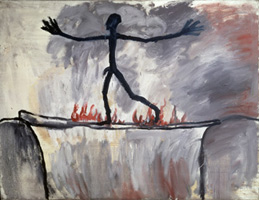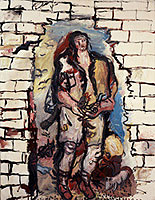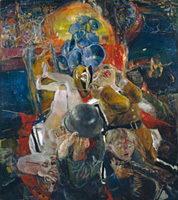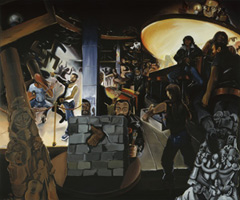

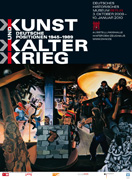
Exhibiton
| 1945-1949 Continuity or New Beginning?
| 1950-1959 Dispute about the Image of Man
1960-1979 Contemporaneousness - Trauma of the Past
| 1980-1989 Manic Normality in Germany
The notion of “contemporaneousness” stands for the expansion of the idea of art and for the artistic use of new media. These years also saw the beginning of a historical and artistic coming to terms with the Nazi past as well as a concomitant radicalization of various political and artistic groups. Capitalist Realism, inspired by Anglo-American Pop Art, became the preferred art of the “economic miracle”. New media, Fluxus, happenings and Body Art vitalized the previously prevailing static notion of art as consisting only of easel painting and sculptures. In the course of social changes and the student movement, leftist artists came to the fore and visualized the “restoring forces of a new society” (Joseph Beuys, 1975).
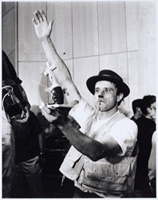
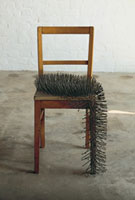
Painters such as Georg Baselitz and Anselm Kiefer, but also Bernhard Heisig and Werner Tübke, took up the topic of the presence of the past. The reappraisal of recent German history was crowded out on the one hand by the “economic miracle” in the Federal Republic and on the other by the “building up of Socialism” in the GDR; in art it now took the shape of sombre phantasmagorias. The sons of the perpetrators and victims painted themselves as both internally and externally battered wayfarers in tattered uniforms who wander, restless and disoriented, through an irretrievably decimated countryside, fully conscious of the fact that they can never return to the sites of their childhood. Georg Baselitz portrays himself with knapsack and artist’s utensils in the wreckage of his homeland, breaking through walls, injured and entangled in hand and foot traps – a representative of an abandoned generation. In his pictures of the Paris Commune, Bernhard Heisig doesn’t use the historical metaphor of the October Revolution, but rather his own wartime experiences to counter the accusation of historical pessimism. Wolfgang Mattheuer begins his painted mythological allegories with Cain, the biblical symbol of the hostile brothers, in order to cope with the trauma of the division of Germany. Werner Tübke in the East and Wolf Vostell in the West both reacted to the Auschwitz trial that was held in Frankfurt am Main in 1964/65. At the end of the 1960s Anselm Kiefer shocked the art world with his symbolic Occupations. There, in territories previously occupied by the German Wehrmacht, he photographed himself with his arm raised in the Hitler salute. Quasi as a proxy for the Germans, Kiefer performs a kind of experiment with himself in taking on the identity of a Nazi. These symbolic occupations of foreign territories represent an initial breach with the German post-war ban on such pictures, a violation of a taboo after the repression of the past that had characterized the 1950s.
